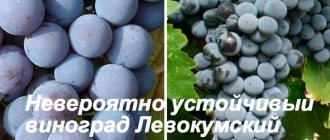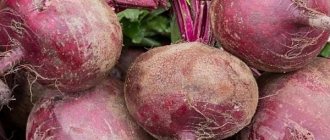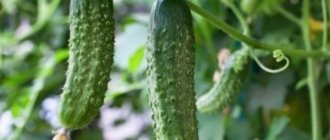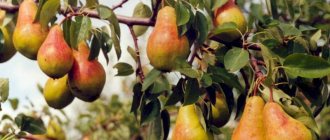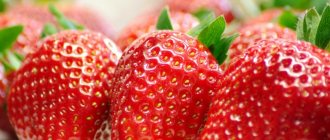A variety of garlic suitable for the climate and soil composition will delight you with a large harvest. Possessing a large list of beneficial properties and an unusual taste, this spicy vegetable is planted by everyone who has a plot of land. To figure out which variety of garlic is the largest, it is first recommended that you familiarize yourself with the description of each of them.
There are two types of garlic: spring and winter. Spring garlic begins to be planted at the end of April, and winter garlic begins to be planted in the spring, at the end of September. Winter types of garlic send out arrows, on which a capsule with seeds is formed. The bulb consists of several large cloves located around a central core. The fruits of spring garlic do not have a stem, and small, numerous cloves are arranged in several rows in a spiral. The closer the slices are to the center, the smaller they are.
Alcor
Winter types of garlic are represented by the Alcor variety, which has medium ripening periods. Up to 11 leaves develop on the stem, the length of which is 40 cm. The arrow extends up to one meter. The feathers are dark green with a slight bluish tint and a pronounced waxy coating.
The bulb is formed with a round shape and dense consistency. The color of the husk is pinkish-lilac with dark purple longitudinal stripes. The head can have up to 5 large cloves. Each bulb weighs 30 g.
For the successful development of garlic, a lot of space is required, and the variety does not have any special requirements for the composition of the soil. Garlic is characterized by stable yield, frost resistance and high disease resistance.
Planting begins in late September or early October. For planting, it is better to select the outer cloves of the bulb. Choose a well-lit, warm place on the site. During the entire period of plant development, it is necessary to weed the beds from weeds, cut off the shoots, water once a week and apply fertilizers on time.
Varieties of large-sized garlic with photos and descriptions
Many gardeners are interested in varieties that produce large fruits. It's almost the same story with garlic. Little garlic, which contains a large number of cloves, is of little interest to anyone. I want something bigger.
One of these large ones was mentioned earlier - this is Gulliver. What other large varieties of garlic can you plant on your plot?
Titanium
The variety is a mid-late variety; the growing season takes 100-115 days. The plant grows short, but quite powerful. The bulb has a rounded-flat shape and weighs from 150 to 180 g. There are very few cloves in it, only 6 pieces. The garlic tastes sharp and juicy. It is stored for about 6 months.
Lyubasha
A variety with a fairly high yield. The bulbs weigh between 100-120 g. The cloves in the head are arranged in one row and their number is 9 pieces.
Siberian giant
The variety is winter, unpretentious in cultivation. However, despite this, it produces an excellent harvest. It belongs to the mid-season, the growing season takes 90-115 days. In addition to good yield, a special feature of the variety is its large bulbs. Their weight reaches 100 g and contains from 6 to 9 cloves. It was bred for cultivation in regions with cold climates. The height of the plant reaches 70 cm, it is stored well, and the taste is sharp and sweet.
Alekseevsky giant
Just like the Siberian giant, it has large teeth. The weight of the onion is about 170 g, it contains from 4 to 5 cloves. The taste is spicy-sweet. It has excellent yield and stores well. Unlike the Siberian giant, it is more popular.
Dobrynya
The advantage is its high cold resistance and adaptability to adverse weather conditions.
The variety is winter, the growing season is from 120 to 130 days. the bulb is round, weighs 60-70 g and contains up to 12 cloves. The taste is slightly spicy, and therefore good for preservation.
It can be stored for up to 6 months, but after 4 months of storage, the cloves begin to deteriorate and its wonderful taste is lost.
Petrovsky
The variety belongs to winter. Its characteristic feature is good yield and keeping quality. The heads have the same shape and weigh up to 75 g. They contain from 6 to 8 cloves. The taste is spicy. Resistant to various diseases, especially fungal ones.
Komsomolets
The variety is mid-season, ripening occurs in 120-125 days. The yield is high: up to 1.5 kg of garlic can be harvested per square meter.
Garkua
Winter garlic includes the Garkua variety. The plant is characterized by medium-early ripening; vegetable growers begin harvesting in mid-June. The peel of the head is white and pink in color.
The main advantages of the variety are high productivity, regardless of soil composition, and winter hardiness. Planted garlic cloves do not freeze even at -20 degrees. The cloves are formed small, and their number reaches 16 pieces.
They begin to plant the vegetable at the end of September in the most illuminated area in the garden. Ideal for clay or sandy loam, loosened soils. The largest cloves without damage or stains are chosen as planting material. After the emergence of seedlings, it is necessary to constantly fight weeds and loosen the soil after each watering.
What types of garlic are there?
The culture is divided into two broad groups: spring garlic and winter garlic. Each of them has its own advantages and disadvantages. Before planting a plant, you must carefully study the planting rules for a particular variety. Spring crops are planted at the end or mid-April, winter crops are planted mainly in the fall.
What is the difference between spring garlic and winter garlic?
The differences are as follows:
- The taste of winter varieties is brighter, so this garlic is more suitable for cooking. This vegetable has a spicy taste and rich aroma.
- Winter varieties boast large sizes - the cloves are large and smooth.
- Spring garlic takes much longer to ripen than winter garlic.
- The winter vegetable has a higher yield - fresh cloves can be used in the summer.
- Spring varieties are stored longer - taste and external qualities remain unchanged throughout the year. While winter crops are stored for only 3-4 months.
- Spring varieties tolerate diseases and parasites better.
Important ! It is impossible to say unequivocally which variety is better - spring and winter. It all depends on the care and region of residence.
Harpek
The garlic variety Garpek is distinguished by its high yield. Refers to vegetables with medium ripening limits; you can start harvesting a mature harvest in mid-July. The head weighs about 70 g and includes 10–12 small, dense, juicy cloves. The color of the bulb is white-violet.
The name of the variety is not so well known among vegetable growers, so in order to make the right choice you need to get acquainted with the characteristics. The variety can withstand winter cold and sudden temperature changes and requires additional measures to strengthen the immune system.
Garlic seeds begin to be planted in mid-September in soil that has previously been dug up and fertilized. Throughout the growing season, you need to loosen and weed the beds. To ensure that all the nutrients flow into the underground part of the plant, it is recommended to cut the arrows with special scissors.
Hermann
Another variety of winter garlic is the German variety. Garlic is a mid-season species; the entire growing season lasts 95 days. The leaves are bright green with an unusual waxy coating, medium intensity, grow up to 60 cm.
In the rounded-flat head, 6 teeth are formed, which have a complex structure. On average, garlic heads weigh 50 g, the scales are colored white and lilac. It has a long shelf life (up to 8 months), provided that the crop was harvested correctly.
To obtain a large and numerous harvest, it is recommended to grow the German variety in a greenhouse in compliance with all the rules. The watering regime should be moderate; the soil should not be over-moistened (drip irrigation is best). During the period of leaf germination, the recommended temperature is +20 degrees, and during the period of active growth it is slightly higher - +23 degrees. To ensure that the bulb receives more nutritional components, it is recommended to trim the arrows. It is imperative to weed the beds, preventing weeds, and apply fertilizers at certain times.
See also
How to properly store garlic at home after digging? Read
Options for the best planting material
A healthy, and most importantly, abundant harvest - this is what everyone who is interested in growing garlic strives for.
To get the desired result, it is important to choose the right planting material, which is completely suitable for the climatic conditions and planting time. Below are the best varieties of winter garlic designed for planting in central regions
Petrovsky
Garlic of a variety such as Petrovsky belongs to the mid-season crop species. The bulbs have a slightly flattened shape and consist of 6-8 cloves. Each weight reaches 75 grams. When dried, the scales are distinguished by a dirty white hue with dark purple stripes along them. The pulp of the cloves is pleasantly soft and has a sharp but not harsh taste.
It is recommended to plant winter Petrovsky in the northern zone in the twentieth of September. Growing in the south dictates different planting dates - no later than the tenth of October.
Lyubasha
Winter garlic Lyubasha was bred in Ukraine, but is also popular among Russian gardeners. The climate in this country is similar to those conditions that are typical for central Russia. The plant is quite large. It belongs to the species of medium ripeness. The variety is grown using winter crop technology.
The average weight of a head of this variety of winter garlic ranges from 80-120 g. Some gardeners managed to grow the Lyubasha variety, whose weight reached 375 grams. Each head has about 7 cloves; in individual bulbs this number can reach nine.
The average weight of a head of Lyubasha garlic is over 100 grams
In terms of its chemical composition, Lyubasha garlic is a universal variety. In other words, it can be eaten fresh, and the best, non-rotten teeth can be eaten as part of the process of preservation, pickling, and sausage making.
Winter garlic Lyubasha stores well and is resistant to various diseases. It is distinguished by a high content of essential oils and various microelements.
Growing the Lyubasha variety is not difficult. Single teeth, cloves, and bulblets are used as planting material.
Sofievsky
The Sofievsky garlic variety is a bolting species, just like Lyubasha. They also have similar other varietal properties. The crop is resistant to all kinds of diseases and has stable and high yields. The bulbs of the Sofievsky variety are large, weighing about 80-120 grams.
Podmoskovny
Another representative of bolting winter garlic, which grows well in the middle zone, is Podmoskovny. Refers to species of medium maturity. Has a universal purpose. Growing the Podmoskovny variety is popular due to the fact that the yield is stable and the crop is resistant to disease. The average onion holds 5-7 cloves. The color of the scales is silvery-white.
Bogatyr
Bogatyr is one of the bolting varieties of winter garlic. The resulting yield is very high, regardless of the type of soil, which explains the fact that the cultivation of the species is in great demand, especially in the regions of the middle zone. Reviews about it from gardeners are the best. The Bogatyr variety got its name from the weight of the bulb - up to 85 g. Although there are some specimens whose weight reaches 115 g. The winter crop of this variety is well stored for a long period. The best large cloves are not only for eating, but also as a seasoning during pickling and salting.
Saved
Spas is another variety of winter garlic that shoots. It is stored well and for a long time, gives a high yield. The average weight of a ripened onion is about 100 g. The head contains eight cloves in total. Cultivation of the Spas variety is, as a rule, widespread in Ukraine, Belarus, Moldova, and Russia (regions of the middle zone). Suitable for various applications:
The arrows of winter garlic Spas are actively used not only as a source of seed material. They are also widespread among chefs as a tasty and healthy delicacy.
Hermidor
The Dutch winter garlic variety Germidor produces a harvest at the very beginning of summer. The large, rounded head reaches a weight of 55-85 g.
Gribovsky anniversary
The high-yielding variety Gribovsky is a bolting variety and is valuable for its excellent winter hardiness. The mid-late ripening of the head allows harvesting after 106 days. The length of the matte green leaves on the stem reaches 30 cm.
The weight of the slightly flattened head is 35 g, with 8–10 cloves collected inside. The scales are light purple with dark purple stripes. The variety tolerates frost, drought, sudden temperature fluctuations well, and is resistant to fungal and bacterial diseases and greenhouse pests. Resistant to attack by nematodes and onion flies. Diseases such as fusarium and viral mosaic often bypass the plant.
Places that are far from the shade of trees, fences or buildings are suitable for planting. Does not develop well in heavy soils; loamy or sandy loam composition is preferred.
Moskal
Giant garlic is popular among gardeners. All varieties are distinguished by large head sizes, the weight of which can be 500 g. Most of them tolerate winter well, are resistant to disease and give the best results. Common types include: Gulliver, Titan, Alekseevsky, Moskal, Yellow Giant, Bashkir-85.
Varietal garlic Moskal is distinguished by its gigantic size and the fact that arrows do not form. The rounded, elongated head weighs 80 g. The scales have a lilac-violet color. At the end of the growing season, up to 4 cloves are formed, each of which weighs 20 g.
Description of spring garlic varieties with photos
Spring garlic is garlic that is planted in the spring and can be harvested in August or October.
Spring garlic is distinguished by its small heads, compared to winter garlic, by a large number of cloves, and it also does not shoot. However, such garlic can be stored even for a whole year without losing its qualities.
Abrek
The variety is mid-season. Does not form arrows. The leaves are 55 cm long and 2 cm wide. The bulb is rounded and flattened, contains 15 cloves and weighs up to 30 g. Covered with white scales. The pulp is dense, white, and has a spicy taste. The yield is high, which distinguishes it from other varieties: up to 1 kg per square meter. The bulbs are stored for up to 7 months.
Victorio
This variety is also mid-season, which does not form shoots. The leaves reach a length of up to 25 cm, and their width is only about 1.5 cm, often less.
Garlics are pear-shaped and can weigh up to 45 g. Each head contains up to 15 cloves. Their flesh is white and the taste is slightly spicy. The variety is good in terms of yield: you can get up to 1 kg per square meter. Garlic can be stored just as well – up to 8 months.
Gulliver
It differs from other spring varieties in the large size of the heads, which weigh on average 120 g, but can be more. Garlic contains from 4 to 7 cloves, and they taste sharp.
The growing season ranges from 85 to 100 days. The plant can grow up to 70 cm in height, and leaves up to 50 cm. The variety is resistant to both low and high temperatures and various diseases. Garlic can be stored for up to 8 months.
Orlovsky
The variety is mid-late. The weight of the head reaches 100 g. It differs from others in its large cloves; they can weigh up to 10 g. There can be from 8 to 10 of them in one garlic. Like all spring varieties, this garlic does not shoot. An important characteristic is its very long storage, it can be stored for at least a year.
By the way, you can plant it in the fall, like a winter plant. However, at the same time, its keeping quality is greatly reduced.
Elenovsky
Like the previous variety, despite the fact that it was bred in the spring, it can also be planted before winter. This is facilitated by its good frost-resistant qualities. The growing season ranges from 110 to 115 days. The bulbs have a flat-round shape. Their weight is up to 40 g. They are distinguished by a large number of cloves; there can be from 13 to 16 of them in one garlic. The taste is slightly spicy. Resistant to diseases.
The use of the variety is universal. In addition to eating fresh, it can be used for pickling and canning. Its long-term storage is considered an advantage. Garlic planted in spring is stored for two years, and in autumn – for one year.
Komsomolets
The best variety of winter garlic is Komsomolets, which tolerates frost well and produces a large harvest that begins to ripen at the same time. The duration of the growing season is 115 days, so garlic is classified as a mid-season plant. The length of the numerous shoots of leaves reaches 40 cm; the shoots can grow more than a meter in length. The color is green with a slight waxy coating.
Dense bulbs weigh 35 g. In good soil, with sufficient fertilizer, the weight can reach 105 g. The color of the husk is light purple. Each head contains 10 cloves.
The variety is highly frost-resistant, unpretentious to care and soil composition, and resistant to many pathogens, especially bacterial rot. The harvest is abundant and of good quality.
To prevent plant growth from slowing down and the yield to remain high, you need to plant it away from the shade, in a well-lit place. The variety does not like wet soil. Planting begins in early October. Before planting, it is recommended to fertilize the soil with compost or humus. After planting, it is advisable to insulate the bed with a layer of mulch (sawdust will do).
Garlic that doesn't make you sick
Separately, I would like to talk about varieties resistant to fungal diseases. They are suitable for those gardeners whose plots are located in low, damp places, and therefore garlic is not always possible there. “Happy” owners of such problematic plots of land can be recommended to plant the Elenovsky variety on the plot. This cultivar is highly resistant to the vast majority of fungal diseases. The only drawback of the Elenovsky variety is that its heads are quite small, only 40 grams, and the cloves are a little more than one and a half grams. However, this variety is quite suitable for winter planting, and if you choose this method of growing, then get ready for an increase in yield by one and a half times, here the heads will add a couple of tens of grams, and the cloves will also “get better” by 3-4 grams. However, the harvest collected from this method of planting must be used in the current season, because it will not be stored at all.
Lyubasha
The giant garlic variety Lyubasha reaches a height of 120 cm and is an early ripening plant. The leaves grow densely, dark green with a medium waxy coating, about 40 cm long and 2 cm wide.
With good care, the flat-round head grows large, weighing up to 300 g. The average weight is 110 g. Each bulb forms 7 cloves, which are covered with whitish-pink scales with purple veins.
Garlic tolerates frost well, produces good yields even in dry years, and does not make any special demands on the composition of the soil. It has high productivity. It can be stored for a long time without losing its beneficial qualities for up to 10 months. It is rarely attacked by pests and almost never suffers from fungal and bacterial infections.
Cloves or seeds are planted before the first frost, until the beginning of November. It is better to plant on a hill where it is dry and where sunlight reaches without obstacles. The site is first dug up, fertilized and beds are made. Care consists of timely watering and removing weeds.
"Pros" and "Cons" of winter varieties
The list of cultural advantages is quite long:
- early ripening;
- high yield, large heads and cloves;
- resistance to adverse environmental conditions;
- sharp, rich taste;
- the possibility of reproduction through sowing seeds;
- fall planting activities free up time for other spring work.
Among the disadvantages:
- the short shelf life of garlic does not allow it to maintain its commercial qualities until the next harvest;
- a small number of cloves and their size increase the specific gravity of the planting material.
Jagged
Winter shooting garlic Zubrenok belongs to the mid-early varieties (the growing season lasts about 95 days). The head begins to ripen from the moment the first spring shoots appear after 105 days. The length of dark green feathers with a light waxy coating reaches 45 cm.
Round heads of garlic weighing up to 70 g are formed large, dense with white-cream scales. Up to 7 cloves can form inside. For planting, it is better to choose a warm, well-lit place.
The positive qualities of the variety are considered to be high yield, winter hardiness, good shelf life (the crop can be stored for up to 7 months), and resistance to fungal diseases.
They begin to sow garlic in early October. After this, it is recommended to mulch to retain heat and additionally provide the soil with microelements. Sawdust, compost, and straw are used as mulch.
Doctor
Early ripening, non-shooting, productive variety. The bulb is round-flat, of medium density, the color of dry scales is white, the color of fleshy scales is light pink or light purple. The variety is winter-hardy, shelf life during 7 months of storage is up to 60%.
| Taste | Number of teeth | Bulb weight, g | Productivity, kg per 1 sq.m | Keeping quality |
| Peninsular | 11-16 | 36-42 (up to 52) | 1,1 | good |
Messidor
Before making a choice in favor of the Messidor variety, you need to get acquainted with the description of this type of garlic. This is a very productive, early ripening variety obtained in Holland. The leaves have a rich dark green color, their length reaches 70 cm. The plant does not form an arrow with bulbs.
See also
When should you harvest garlic in a rainy summer to save it from rot? Read
The round white bulb weighs about 115 g and contains up to 14 cloves. The plant rarely gets sick, the harvested crop can be stored for a long time. Planting begins in late September or early October, and harvesting begins in late June. The maturity of the heads is judged by the condition of the feathers, neck of the bulb and scales on it.
Garlic is resistant to many fungal, viral and bacterial diseases, and tolerates winter with severe frosts. It is possible to collect a rich harvest, which is stored for a long time.
Large, undamaged seeds are selected for planting. If more than three cloves do not form in the head, the seeds are not selected, since the culture is degenerating. Fertilizing is carried out three times throughout the entire season; weeds should not be allowed to appear; watering should be moderate.
Petrovsky
Petrovsky, a winter variety of garlic that throws out arrows, has average limits of root maturation (massive yellowing of leaves from the moment they appear begins after 100 days). The flattened white-violet head weighs about 80 g. Up to 6–8 light brown cloves are formed inside. The dark green leaves are covered with a waxy coating.
The variety is characterized by the formation of a rich harvest, good keeping quality and resistance to diseases. Garlic thrives in fertile soil with neutral acidity. For planting, choose a sunny, dry place in the garden. It is recommended to plant three weeks before the onset of cold weather (in late September and until mid-October).
After the first shoots appear, the beds begin to weed and loosen. Fertilizers are applied three times during the entire growing season. The first time fertilizer is applied when three leaves appear. The last fertilizing is carried out three weeks before harvest.
Dubkovsky
Dubkovsky garlic belongs to the winter bolting plants. By the middle of the growing season, arrows with seeds are formed. The variety belongs to the mid-season species; about 105 days pass from the appearance of the first spring shoots to the period of ripening of the bulbs. Valued for its ability to reproduce by aerial bulbs, which have a pale purple hue.
The leaves are bright, rich green in color with a faint waxy coating, their height is about 35 cm. The heads are round, slightly flattened, weighing about 35 g. The scales are white-violet. Up to 12 dense lobules are formed inside, their structure is simple.
If you follow the rules of agricultural technology and proper care, you get high yields, up to 7 kg per hundred square meters. The advantages of the variety include frost resistance, long shelf life and resistance to fungal diseases.
It has been noticed that garlic is often affected by nematodes, so preventive treatments of vegetable beds are carried out in a timely manner.
Polesie souvenir
The bolting type of winter garlic, bred by Belarusian selection - Polessky Souvenir - has good characteristics. Refers to mid-season varieties, the growing season lasts 100 days.
On one stem, up to 10 dark green leaves with a waxy coating of medium intensity, 58 cm long, unfold. The weight of one rounded bulb with medium density and pinkish scales reaches 150 g. Up to 7 large cloves are formed inside.
The variety tolerates frosty winters well, is stored for a long time (up to 8 months) and quickly adapts to various conditions, resistant to many infections and pests. Characterized by almost 100% germination.
Planting material begins from mid-August to early September. Can be grown both in a greenhouse and in open ground. Garlic requires frequent weeding, at least three drop waterings per season, and responds well to potassium fertilizing and superphosphate fertilizers. During the mass formation of arrows, they are cut off. It is not recommended to plant garlic in the same place for more than three years.
Saved
Garlic Spas has positive characteristics: it withstands winter with frost, is resistant to common infectious agents, and is not susceptible to nematodes. A rich harvest always ripens and is stored for a long time. Refers to plants with average maturation of heads. About 110 days pass from the moment of germination to complete lodging of the tops.
About 11 dark green leaves with a light waxy coating, up to 35 cm long, unfold on the stem. In the middle of the growing season, many arrows with seeds are formed.
The bulbs have a round-oval shape, weighing 90 g. The structure of the cloves is simple, their number reaches 8 pieces in one head. The color of the scales is gray-red with purple longitudinal veins.
It can only be grown in open ground, in a well-lit and dry place. Caring for vegetable beds consists of timely application of fertilizers, frequent weeding, loosening and moderate watering.






